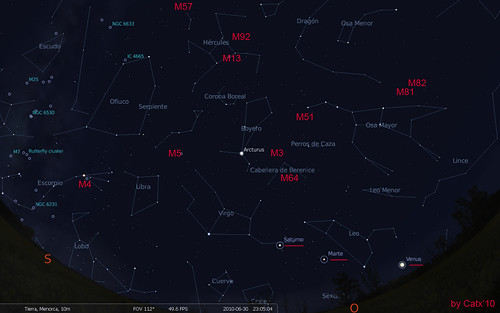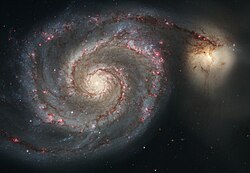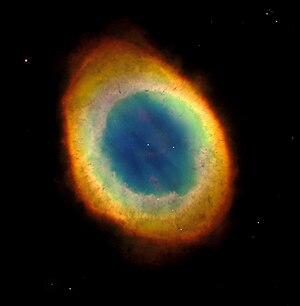 Hace ya un tiempo q no puedo sacar el telescopio con calma y en condiciones, además de no poder asistir a las últimas salidas realizadas por Astromenorca y aprender de esta gente. Ya sea por el tiempo q nos ha hecho los últimos meses ( lluvia, nubes, lluvia, nubes... ) o por las labores hogareñas y familiares, creo q mi equipo está empezando a echar telarañas. A ver si ahora q viene el veranito (y antes de q nazca nuestro segundo hijo ;) , puedo desempolvar mi teles. y ponerme to enjoy this fantastic sky q # we Menorca.
Hace ya un tiempo q no puedo sacar el telescopio con calma y en condiciones, además de no poder asistir a las últimas salidas realizadas por Astromenorca y aprender de esta gente. Ya sea por el tiempo q nos ha hecho los últimos meses ( lluvia, nubes, lluvia, nubes... ) o por las labores hogareñas y familiares, creo q mi equipo está empezando a echar telarañas. A ver si ahora q viene el veranito (y antes de q nazca nuestro segundo hijo ;) , puedo desempolvar mi teles. y ponerme to enjoy this fantastic sky q # we Menorca. Even with these setbacks, my love of astronomy is still growing (very amateur plan, of course), so I have to feed it with various news articles and blogs I q, and of course, reading what we see in our Heaven in every season, this being a great way to learn the most visible and important objects in the sky, and the phenomena that are happening over our heads and go unnoticed by most of us. This entry
's turn to the sky late June. With the occasion of the visit friends who live in Barcelona (qa he also does the theme of astronomy), prepare a dinner at home and then a small astronomical observation, to see what we see. To expedite the matter, prepare this entry through the main things we can observe q the night of June 30 (if clouds ladies ... we allow;). Let's start!:
- Charter and locate celestial objects mentioned in this post: (click to enlarge)

- Luna:
Our dear satellite entered the last full moon day 26 ( today writing this post q ;) So that becomes our main "enemy" to the time to enjoy deep sky objects. Day 30 will already have begun to reduce its surface illuminated but also not allow us to enjoy concessional items. "Lucky" will not appear on the eastern horizon until midnight, so if dinner prontito ... until 00:00 we try four little things look deep sky. Then, once displayed the moon, we will devote to planetary observation (if still present) and visible objects.
And of course, we can always "pull" to the moon, because that's always an interesting observation and grateful.
- Planets:
Venus, Mars and Saturn, all three will have aligned obliquely in the West. Too bad its proximity to the sun when it is placed at q does not give us much room for time to review it. Venus
we see (as in the past few months) as a big, bright star just at sunset But if we do not hurry, possibly at 23:00 h and will not be visible so ... A QUICK DINNER! ;)
Mars and Saturn are less bright but give us a bit more margin. The downside is that it also is very near the horizon, so that possibly the city lights do not allow us to view them with comfort ...
- Constellations and Deep Sky:
Having the moon peeking through the East, not the best time of the month to devote to deep sky objects, but ... As I explained before, we have a small margin to 00:00 h in the light of the moon will not interfere directly in the observation (buf stress ... q! ;) Here is a small collection of objects interesting. Try to focus on the brightest objects in the West Area, and to the East we have the reflection of the moon, in addition to the planets also in that direction. Q A view out.
In this time of year we began to notice the change of constellations. The Summer begin to be observed every time the MCAS. Moreover, as the night goes on q we can distinguish the so-called "Summer Triangle " formed by the stars Deneb (in Cygnus), Altair (in eagle), Vega (in Lyra).
Focusing on deep sky objects, and looking towards the West, we find the following ( images and links are taken from the Wikipedia. Of course the eye with the telescope do not look like, you can just see his way and main features, as well as black and white view due to "limitations" of our eyes ...) :
- M51: The Whirlpool Galaxy, one of the brightest in our sky, located between the Big Dipper and Hounds.

- M64: Galaxy black eye, a curious object in pretty good condition. Located in the center of Berenice.

- M81 Bode's Galaxy and M82 Cigar Galaxy. Both lying between Ursa Major and Ursa Minor (I have q q recognize its position so close to the North Star ... I still have not managed to locate, having q put the telescope in a position almost inhuman for observation ...)
- M3 : One of the brightest globular clusters, with an apparent magnitude of 6.2.
- M13 and M92 : two large globular clusters located in the constellation of Hercules. M13 is also known as "Great Hercules Cluster (image)

- M4: Globular Cluster in the constellation Scorpius. We're a bit south, but I think q be worth a try. It's one of my favorite things because, along with the Andromeda Galaxy, it was my first deep sky object I observed:) Also, next we find Antares, the star brightest of the constellation, also known for its orange color.

- M5: Globular cluster located in Serpens.
- M57: Ring Nebula. Planetary nebula located in our galaxy visible in the constellation Lyra. If it's not visible tonight and that is to the east, so the Moon can avoid visibility, but I think it might be interesting to try.

I q nothing else. It is a small collection, let me crowd knowing q d objects, but I think q these are the most visible and interesting. For
more information do not hesitate to visit w ww.elcielodelmes.com
See you all! ;)